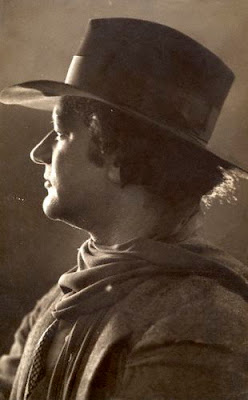Jacob Epstein. Self-portrait (c1901). Red chalk.
Jacob Epstein. Photo: George Charles Beresford (1924).
Jacob Epstein, A Hester Street Crowd ca 1900-02, black crayon. illustration for Spirit of the Ghetto. Jewish Museum NY, Soltes, Fixing the World, p.5.
Jacob Epstein. Tomb of Oscar Wilde, Paris (1909-1912).
Jacob Epstein. Coventry Cathedral, England. St. Michael and the Devil (1958).
Happy Birthday Jacob Epstein (10 November 1880 – 19 August 1959)
by Samuel D. Gruber
This has been a week for sculptor's birthdays! First Mark Antokolsky, then Seymour Lipton, Nathan Rapoport and now Jacob Epstein. If anyone doubts that Jews adapted with gusto to three-dimensional and often figurative sculpture in the late 19th and 20th centuries, this line-up should prove them wrong - and these sculptors are just a few of the many born during other months of the year.
Epstein was a pioneer of modern sculpture. Born in the United States, he was the child of Polish-Jewish immigrants and grew up on the Lower East Side. His first significant commission was to illustrate Hutchins Hapgood's Spirit of the Ghetto, for which he produced a series of naturalistic street scenes of mostly Jewish characters and life from the world he knew well. The scenes are anecdotal and sympathetic. His drawing style was strong and fluid. With the money he earned he moved to Europe in 1902, and became a British citizen in 1911.
Jacob Epstein. Bust of (artist) Jacob Kramer, bronze (1921). Leeds City Art Galleries.
Jacob Epstein. Bust of Chaim Weizmann (c1950). Bronze. Jewish Museum, London.
Epstein's personality was as strong as his work, and he became a leader of the English avant-garde - rebelling against a wide variety of artistic and social customs and conceits, and establishing himself as a archetypal bohemian artist (if that is not a contradiction in terms). He produced controversial work and supported the underdog. Yet, over his career, he became a favorite artist of the English Church and both the intelligentsia and liberal aristocracy. At the time of his death in 1959 he was celebrated as both England's leading portrait sculptor and artist of monumental works. In his portraits - including many of leading Jewish artists and cultural figures - he was able to capture a moment, giving his work a liveliness that was quite at odds with much of the staid portraiture of English tradition. For his monumental works - many of which had Christian or allegorical meaning - he created figures in mythic time; often massive in size and deliberate in gesture.
You can read more about Epstein here.
Epstein continued to draw throughout his career both creating hundreds of dynamic preparatory studies for his sculpture, and also endpoint works. In retrospect his facility and style(s) seem to owe more to the great 17th-century artists like Bernini, Rubens, and Van Dyke than to the expressive masters of the 19th-century, like Rodin. Epstein's example paved the way for new generations of figurative sculptors, but also the mid-century English abstraction of Henry Moore and Barbara Hepworth.
Jacob Epstein. Two Studies for Jacob and the Angel (1939-40), pencil.
Jacob Epstein, sculptor. Social Consciousness. Philadelphia (1951-53).












No comments:
Post a Comment